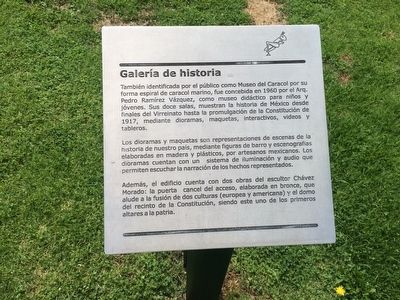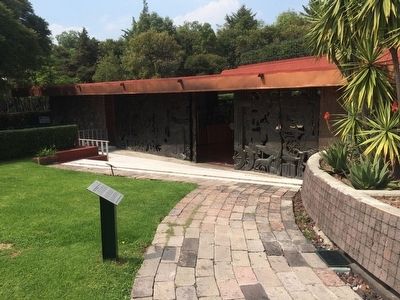Colonia Bosque de Chapultepec I Sección in Ciudad de México, Mexico — The Valley of Mexico (The Central Highlands)
Gallery of History
Galería de Historia
También identificada por el público como Museo del Caracol por su forma espiral de caracol marino, fue concebida en 1960 por el Arq. Pedro Ramírez Vázquez, como museo didáctico para niños y jóvenes. Sus doce salas, muestran la historia de México desde final del Virreinato hasta la promulgación de la Constitución de 1917, mediante dioramas, maquetas, interactivos, videos y tableros.
Los dioramas y maquetas son representaciones de escenas de la historia de nuestro país, mediante figuras de barro y escenografías elaboradas en madera y plásticos, por artesanos mexicanos. Los dioramas cuentan con un sistema de iluminación y audio que permiten escuchar la narración de los hechos representados.
Además, el edificio cuenta con dos obras del escultor Chávez Morado: la puerta cancel de acceso, elaborada en bronce, que alude a la fusión de dos culturas (europeas y americana) y el domo del recinto de la Constitución, siendo este uno de los primeros altares a la patria.
Also commonly known as the Conch Museum for its spiral shape similar to that of a sea conch, it was conceived in 1960 by the Architect Pedro Ramírez Vázquez, as a teaching museum for children and youth. Its twelve rooms show the history of Mexico, covering the period from the end of the Viceroyalty until the promulgation of the 1917 Constitution, through dioramas, models, interactive videos and story panels.
The dioramas and models are representations of scenes from the history of our country using clay figures and scenery made of wood and plastic, all by Mexican artisans. The dioramas have a lighting system and an audio system that allows the visitor to listen to the narration of the events depicted.
In addition, the building has two works by the sculptor Chávez Morado: the entryway, made of bronze, which refers to the fusion of two cultures (European and American) and a domed enclosure dedicated to the Constitution which is one of the first altars of the nation.
Topics. This historical marker is listed in these topic lists: Entertainment • Man-Made Features. A significant historical year for this entry is 1960.
Location. 19° 25.134′ N, 99° 11.002′ W. Marker is in Ciudad de México. It is in Colonia Bosque de Chapultepec I Sección. The marker is directly in front of the main entryway into the Museum as one walks across the spiral sidewalk over the roof. The entryway is accessible from the main ramped walkway up to the Chapultepec Castle. Touch for map. Marker is in this post office area: Ciudad de México 11100, Mexico. Touch for directions.
Other nearby markers.
At least 8 other markers are within walking distance of this marker. José María Morelos y Pavón (within shouting distance of this marker); The Eagle and the Serpent (about 90 meters away, measured in a direct line); Fernando Montes de Oca, Child Hero of Mexico (about 150 meters away); The March of Loyalty (about 210 meters away); The Military College of Mexico (about 210 meters away); Francisco Marquez, Child Hero of Mexico (about 240 meters away); The Chapultepec Audiorama (about 240 meters away); The Mexican Expeditionary Air Force and Squadron 201 (approx. 0.2 kilometers away). Touch for a list and map of all markers in Ciudad de México.
Credits. This page was last revised on April 17, 2020. It was originally submitted on December 4, 2015, by J. Makali Bruton of Accra, Ghana. This page has been viewed 321 times since then and 5 times this year. Photos: 1, 2. submitted on December 4, 2015, by J. Makali Bruton of Accra, Ghana.

